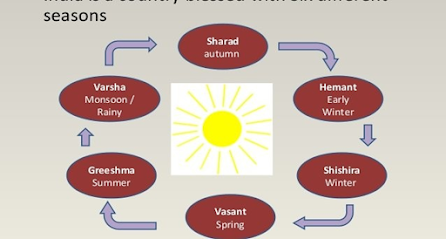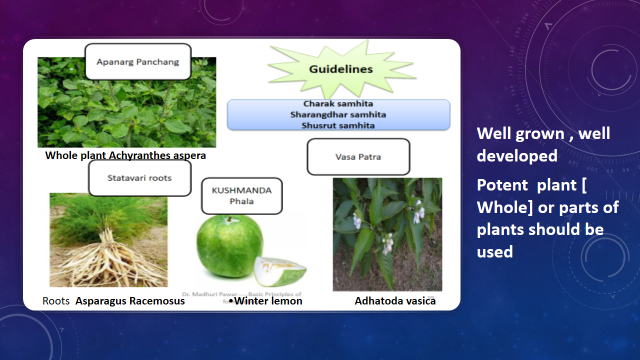Dr Madhuri Pawar
Tuesday, 20 August 2024
Published article on dietary product based on Green gram : Title -THERAPEUTIC POTENTIAL OF MUDGA YUSHA TOWARDS ASSOCIATED SYMPTOMS OF MENSTRUATION
Tuesday, 9 July 2024
Dr. Madhuri Pawar
Uttarayan [ AADAN KAAL]-- The ascent of sun in this time span / northward movement of sun, hot environment, increases dryness in body and reduces Sharir Bala[ strength] of body. Light to digest foods, watery, juicy liquid products consumption suggested.
Dakshinayan[ VISARGA KAAL] --The descent of the sun observed, movement towards southern direction. Cold and unctuous environment. Strength of person increases, digestive power becomes strong, one can eat healthy, unctuous and heavy to digest , energy providing food articles
Further, it is stated that these two time periods are then explained in Six rutu kaal[ seasons]. It is emphasized in ayurved science to observe the changes taken place as per season related to temperature, humidity, weather and accordingly certain conducts are suggested for each season. If one can use and follow the guidelines or specific rule in relation to good conducts, then person can manage his or her healthy status in appropriate manner. Following theses rules helps to prevent health and get rid from illnesses.
Following are the six rutu [seasons]explained given in figure
For Shishir Rutu [ Autumn ]
Here environment remains cold and cold weather, wind. Gaiing of energy is observed in this season.
Due to this aggravation of Kapha entity is seen in body and Agni[ digestive power] of person is at higher level.
Thus, persons having good status of digestive power can consume wheat based/ cereal based/ rice based gruels, porridges, milk based products. Ghee processed products like sweets, laddos are suggested to consume. Along with this regular exercises other than regular activities should be done to maintain healthy condition of body.
For Hemanta Rutu[ Late Autum]

Lifestyle Recommendations
|
- Vata Aggravating foods such as cold, dry nature foods, cold drinks and light to digest to be avoided.
Friday, 16 December 2022
Basic pharmaceutical Principles of Ayurvedic Formulations :
Dr. Madhuri Pawar
Associate Professor, BVDUCOA, Pune
Content :
Principles for selection of raw materials[ Herbs, Mineral-metals, animal products]
Principles for manufacture of ayurvedic medicines
Ayurvedic pharmaceutics deals with preparation of herbal and herbomineral formulations by applying specific guidelines and principles enumerated in classical texts.
Thursday, 10 November 2022
Hair Care : Transformation of potent group of Herbal drugs in Gel form
Dr. Madhuri Pawar, Dr. Nilima Dharkar
Ayurvedic literature reveals that avoidance of oil application and improper cleaning of scalp, sleeping in day time, night vigil, exposure to dust, hot weather are the causative factors for development of dandruff.
As per ayurvedic perspective, due to vitiation in Vata and Kapha entities, dryness occurs and specific symptoms are predominantly seen at that region. These specific symptoms can be correlated with dandruff.
Due to imbalanced diet, environmental pollutants and improper hair care, individual’s scalp may get affected. Dandruff is a scalp disorder which is characterized by excessive shedding of skin cells, itchy-flaky skin and invisible inflammation. Human beings are more prone for occurrence of dandruff at puberty to middle age.
Moreover it is stated that approximately 50% adult population is affected by dandruff worldwide while the 18.38% Indian community is affected by this disorder.
To combat with occurrence of dandruff and associated symptoms, various anti dandruff agents having chemical entities in the form of shampoos, gels, creams etc are utilized in existing current practice.
Though these agents have therapeutic potential to treat dandruff like disorders but might be having risk to produce untoward effects to human scalp and hair.
Thus specific herbal drugs mentioned in ayurvedic literature having anti itching, antifungal and anti-inflammatory actions are helpful to treat such conditions and useful to get rid from dandruff .
These herbs can be converted into different current, easy applied cosmetic forms , especially in gel forms for management of dandruff which are considerably safe and effective . Additionally, it might be helpful to reduce hair fall and maintain healthy status of scalp and hair.
Herbs: Raktachandan, Neem, Daruharidra, Sarshap, Karanj, Aragvadha, Musta etc
Different potent parts of these herbal drugs --can be used in single or in combinations, can be modified with new innovation methods of preparations. These new developed forms [ Shampoos, oils, gels] of herbs might be effective and may show higher shelf life.
ve
dandruff.
Friday, 19 November 2021
A Book Review : Ayurvedic Nutrition and cooking
Ayurvedic
Nutrition and Cooking : Book Review
Living a Healthy Life with a healthy
food is the concept elaborated easier written by author, Dr. Sunanda Ranade
The
book is a great source of healthy recipes for both beginners and experienced
persons who are much more affectionate towards Ayurved. Book is featuring
delicious, easy to make recipes by simple complete explanation with beautiful
photos. This is possibly the best recipe book one can read.
The
traditional ayurvedic diet is purely put in a modernized version of the foods
that our ancestors ate, hence the name “Ayurvedic nutrition and cooking”. Ayurvedic nutritional diets are made up of nutrient-rich
organic foods, includes different types of cereals, grains, natural oils, fats,
nuts, fruits and additive herbal drugs. The food articles mentioned are
prepared by application of basic principles of ayurvedic traditional science.
Great efforts are taken by author to describe fundamental concepts of body-mind constitutions,
assessment of individual’s physical and psychological characteristics. The
attempt is made by author to address importance of daily food items for
specific constitution in purview of prevention and management of illness.
Especially
in basic principles of nutrition chapter explanation about wholesome and
unwholesome dietary products, accountability of eight factors in dietetics,
quality properties and pharmacological actions of food substances are well
narrated. Outstanding recipes from the book include milk processed with herbal
drugs, Indian specific snacks and rice recipe, leafy-non leafy vegetables-curries
processed with spices and coconuts, variety of mouth -watering pickles. All
these food articles are often served as snacks, main course foods and some are
the taste enhancers.
The book does offer advice about the benefits of
these food stuffs in relation to ayurvedic Vata-Pitta and Kapha entities along
with the desired effects on constituents of human being. This book will play an
important role to globalize the concept of ayurvedic cooking.
Dr.
Madhuri Pawar, Associate Professor
Dept
of Ayurvedic pharmaceutics and pharmacology
BV[Deemed
to be University] College of Ayurved, Pune
Research Article Published in e journal of Ayurved --reference for PG student
Rasamruta, 12:16, August 2020
Preparation and toxicity study of Kukkutand Twak [Hen Egg Shell] Bhasma treated
[Bhavana] with different herbal juices
Dr. Madhuri Pawar*
Bharati Vidyapeeth [Deemed to be University], college of Ayurved , Pune
Abstract
Introduction: Kukkutand twak bhasma is the ayurvedic medicine advised to treat calcium
deficiency and leucorrhea like disease conditions. In preparation of KTB variations are found in
usage of herbal drugs and pattern of temperature for incineration.
Objectives: Thus the attempt was made to formulate KTB samples with different herbal
combinations and temperature ranges on Kukkutand twak [KT]. Physico- chemical analysis and
safety data of KTB is generated.
Material and methodology: Purified KT was processed in Kumari Swaras and incinerated in
Gajaputa to prepare four samples of KTB. While KT was triturated with Kumari Swaras, Nimbu
Swaras and Gulab Jala, processed in Laghu Puta to prepare three samples of KTB. Analysis of
KTB samples was done in laboratory. One sample of KTB was tested for toxicity through acute
and subacute studies.
Results and conclusion: KTB prepared in seven and three Gajaputa revealed white colour but
little bit burning sensation. KTB-M-7GP showed high percentage of calcium than other KTB-GP
samples. KT incinerated in three cycles of Laghuputa showed grayish colour with no burning
sensation and estimated quantitative concentration of calcium. In acute toxicity study, animals
didn’t show any mortality and morbidity. In subacute study, sample of KTB didn’t show any
abnormal change in ileum and bone; insignificant inflammatory lesions are observed in liver and
kidney. Present study has demonstrated different preparation methods and analytical data for
KTB samples processed in Gajaputa and Laghu puta. Acute and subacute toxicity study records
have been illustrated for KTB sample processed with Kumari Swaras in Gajaputa.
Wednesday, 22 April 2020
|
Sr.No
.
|
Material Used
|
Part Used
|
Quantity
|
|
1.
|
Guduchi (Tinospora cordifolia)
|
Whole plant
(Total)
|
5000gms
|
|
1.1
|
Guduchi stem
|
Kanda
|
3500 gms
|
|
1.2
|
Guduchi leaves
|
Patra
|
1000 gms
|
|
1.3
|
Guduchi roots
|
Moola
|
500 gms
|
|
2.
|
Water
|
-
|
1200mL
|
|
Sr.No
|
Raw
Drug used
|
Quantity
|
Time
required to manufacture
|
|
1.
|
Guduchi
swaras
|
350mL
|
45
Min
|
|
2.
|
Sita
(Sugar)
|
700
gms
|
|
ORGANOLEPTIC
TEST
|
||
|
Sr.No.
|
Parameters
|
Observations
|
|
1.
|
Shabda
|
-
|
|
2.
|
Sparsha
|
Picchila
|
|
3.
|
Roopa
|
Dark
Green colour
|
|
4.
|
Rasa
|
Tikta
|
|
5.
|
Gandha
|
Ugra Gandhi
|
|
ORGANOLEPTIC
TEST
|
||
|
Sr.No.
|
Parameters
|
Observations
|
|
1.
|
Shabda
|
Not
applicable
|
|
2.
|
Sparsha
|
Khar-Sushka
|
|
3.
|
Roopa
|
Cream colour
|
|
4.
|
Rasa
|
Madhur-Tikta
|
|
5.
|
Gandha
|
Sugandhi
|








